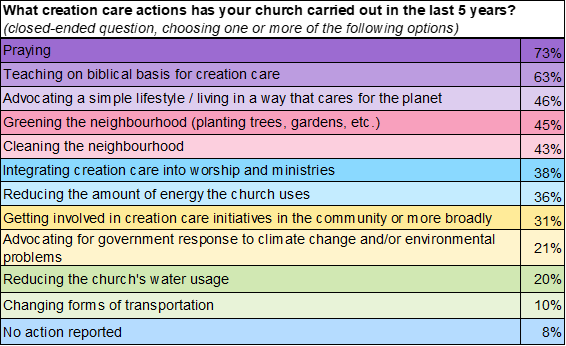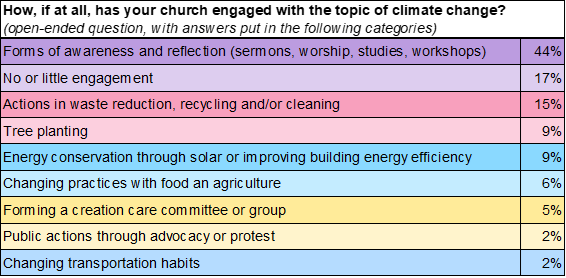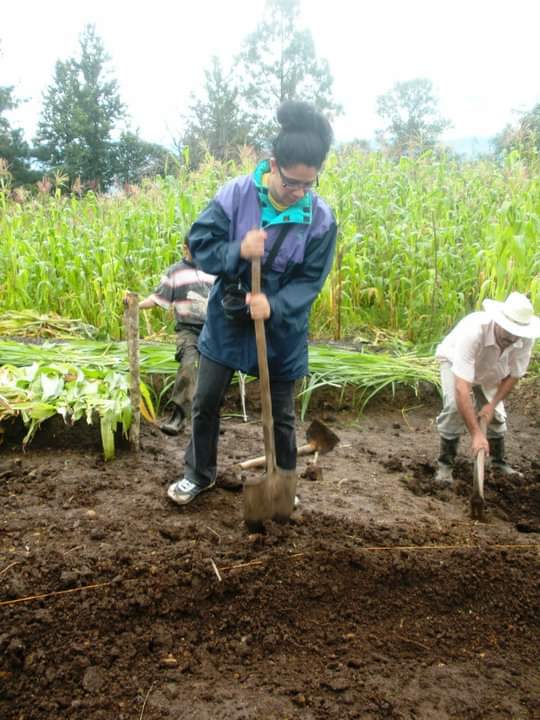Posted: January 5, 2022
Our previous stories from the global survey shows that 1) Mennonite-Anabaptist congregations around the world are being impacted by environmental issues such as climate change in diverse ways, 2) are feeling anxious and sad due to those impacts, and 3) are talking some about creation care in their churches.
But how exactly are churches feeling called to respond to issues of creation care, including climate change?
To find out how churches are responding, the task force asked two sets of questions: one “closed-ended” giving a list of possible responses to creation in general, and the other “open-ended” asking to identify any responses their church has had to climate change specifically.
These results help us to understand how churches might best inspire church members in creation care work.


Churches commonly engage creation care through teaching, reflection and worship

“Church youth usually take advantage of evangelism sessions to make people aware about the consequences of climate change and how to stop its effects.”
—Thioro Bananzoro, Église Évangélique Mennonite du Burkina Faso
When responding to creation care needs, churches naturally engage through traditional church activities such as sermons, worship, prayer, Bible studies and awareness-raising activities such as workshops. These are spiritual, intellectual, or emotional responses that often do not directly reduce environmental impacts in the same way as other direct actions.
Sometimes perceived as ‘just talking’, these actions are in fact an important step in “doing” creation care. Churches clearly value these actions, and they should be acknowledged as critical aspects of encouraging church engagement.
Common actions centre on waste, plants and energy
“With our limited resources every year at least 150- 200 households are being supported for tree plantation in their yards.”
—Shemlal Hembron, Brethren In Christ Church, Nepal
Several categories of more “direct” action were commonly reported.
Many congregations, especially in Latin America, reported actions that addressed the impacts of waste, by having neighbourhood cleanings, promoting recycling, or producing less waste.
Planting trees or gardens is another common action seen in all areas, and mirrors general worldwide interest in plant- and food-based solutions.
Reducing energy through increased efficiency, or by solar energy installation, was a common response in North America, but was rarely mentioned in other areas.
All of these actions represent socially acceptable actions that are relatively easy for church groups to do together, and that have co-benefits (such as better health from cleaner surroundings, or cost savings from reduced energy use). Engaging with these actions are a good way for churches to begin having a positive impact on the environment in their communities.
Some important actions receive less attention by churches

“Our church has engaged with the topic of creation care through preaching, political activities, membership in organizations that promote awareness for environmental care, ecumenical celebrations such as vespers on creation day.”
— Jürg Bräker, Mennoniten Gemeinde Bern (Alttäufer) (Mennonite church of Bern, old Anabaptist), Switzerland.
The quote above represents how many congregations are engaged with creation care on several levels, but is unusual in mentioning involvement with political activities. In fact, public actions of advocacy are an area that was consistently low on the list of activities at churches, and the majority of churches involved at this level are in North America and Africa.
Similarly, few people mentioned changing modes of transportation, and there were very few responses that said they were working directly with changing consumption patterns. All of these represent actions which involve more risk, are more difficult to implement or are not applicable to all contexts (consumption varies tremendously by region, for instance).
Nevertheless, these are all areas that have high impact for environmental issues, and churches should consider the value of actions in these areas if they wish to have a real impact on how societies address environmental problems.
As Anabaptists, we’re known for an emphasis on living out our faith. These results show ways this is happening with creation care, while also pointing where churches can be more involved in tangible actions. What do churches need to increase their engagement in these actions?
Next month we’ll look at what resources and learnings churches say they need in order to faithfully care for God’s creation.
Response
Be inspired by the stories of creative efforts of Anabaptists engaging with creation care.
- Find global stories of creation care through Mennonite World Conference, including this Young Anabaptist voice from Zimbabwe, and the Meserete Kristos Church efforts at tree planting in Ethiopia.
- The Mennonite Creation Care Network shares stories of church actions, and developed the excellent creation care curriculum “Every Creature Singing“.
- The Center for Sustainable Climate Solutions provides resources and stories such as the Shifting Climates podcast.
- Watch for creation care themes at the upcoming MWC Assembly in Indonesia.
Welcome to a series on environmental problems and the global church.These stories illuminate a) how Anabaptist-Mennonites are affected by environmental degradation, Story #1: How environmental crises impact church communitiesStory #2: How do environmental problems make people feel?Story #3: How does climate change intersect with other community challenges?Story #4: Are our churches and leaders engaged with creation care?Story #5: How do churches practice creation care?Story #6: What would help churches engage more with creation care? |



Join the Conversation on Social Media
FacebookTwitterInstagramFlickrYouTube